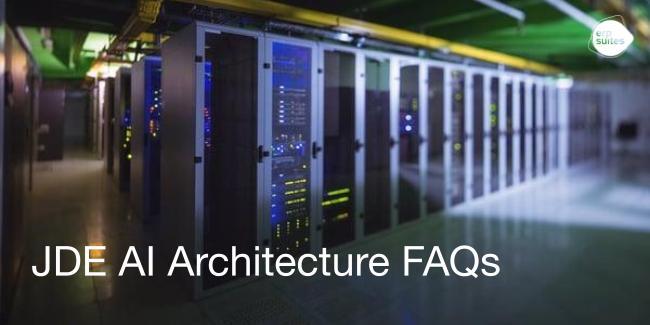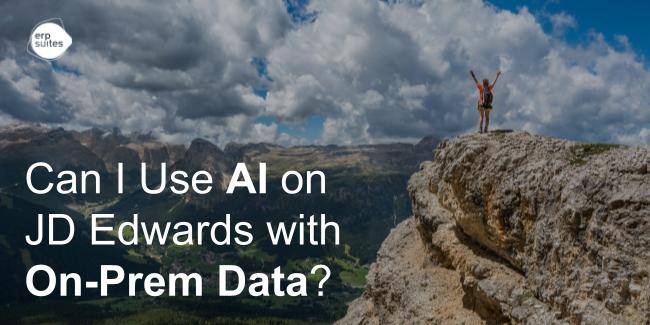5 Common Pitfalls When Implementing AI with JDE
December 18th, 2024
4 min read
.png?width=960&height=540&name=Blog%20Images%20(87).png)
You’ve invested years into optimizing your JD Edwards (JDE) system. You’ve built processes, collected customer data, and grown your business around this ERP solution. Now you’re hearing about Artificial Intelligence (AI) and how it could be the key to unlocking new efficiencies, automation, and insights.
You’re intrigued. Could AI truly supercharge your existing investment in JDE? Or are you opening Pandora’s box of expensive, complicated, and risky changes? You might be asking yourself: What if AI doesn’t integrate well with JDE? What if it ends up being a costly experiment with no real ROI?
We hear you. At ERP Suites, we’ve seen the struggle of integrating AI with legacy ERP systems. We’ve also seen how powerful Enterprise AI can be when it’s done right.
Check out this ten-week AI Starter Guide to see what Enterprise AI looks like.
In this article, we’ll explore the common pitfalls of implementing AI with JD Edwards and, more importantly, how you can avoid them. By the end, you’ll walk away with a clearer understanding of what to expect, what to watch out for, and how to unlock the full potential of your JDE system through AI.
Why Integrating AI with JD Edwards is Challenging
JD Edwards is a workhorse ERP system. For decades, businesses have relied on it to manage complex operations. However, while JDE excels at processing and storing structured data, it wasn’t originally designed to analyze that data or provide analytical insights.
That’s where AI comes in. AI can automate repetitive tasks, predict outcomes, and spot anomalies faster than any human. It can be used to forecast financial trends, automate manufacturing processes, or instantly flag supply chain issues. Now combine all that with JDE’s capabilities and you’ve got a big business boost.
But integrating AI with JDE is easier said than done. Here are five common pitfalls you might encounter:
- Data silos and integration complexity
- Legacy system limitations
- Skill gaps in AI and JDE expertise
- High implementation costs
- Change management resistance
Data Silos and Integration Complexity Can Hold You Up at the Front End
JD Edwards holds a treasure trove of business data. It’s structured for storage and hardware optimization. Each department—manufacturing, finance, sales—might have its own data sets. This works great for running day-to-day operations, but it’s not ideal when you want AI to analyze patterns or predict trends.
That’s because AI thrives on integrated data, and without it, your AI tools won’t be able to give you the insights you’re looking for.
Let’s say you want an AI tool to forecast manufacturing costs. It needs to pull data from a variety of sources, including supplier records, production schedules, and financial ledgers. If any of these data sets are inconsistent, incomplete, or trapped in silos, your AI’s output could be unreliable.
The Solution:
- APIs and Orchestration Tools: Use APIs and middleware to connect JDE data with AI tools.
- Data Housekeeping: Before implementing AI, clean and unify your data. Eliminate duplicates, standardize formats, and ensure data consistency.
- AI Agents: Train AI agents to understand your JDE data structure and processes. These agents can identify anomalies and suggest optimal solutions.
The Takeaway
Integrating AI with your existing JDE requires accessible, clean and consistent data. Use JDE technologies like APIs and Orchestration tools to connect these two and start your implementation.
Legacy Systems Require Continuous Upgrades to Overcome Limitations
While JDE is a robust system, its architecture wasn’t originally built with AI in mind. As such, legacy versions of JDE might lack the connectivity or flexibility needed for seamless AI integration. But just because it’s an older system doesn’t mean it can’t be taught new tricks.
The Solution:
- Stay Updated: Oracle continues to invest in JDE, adding AI-friendly features and tools. Upgrading to the latest version of JDE or adopting Oracle’s cloud services can make AI integration much smoother.
- Leverage Cloud Solutions: Oracle Cloud Infrastructure (OCI) offers AI services that are designed to work with JDE. Other cloud providers like AWS and Azure can also support AI integration.
The Takeaway
Maintaining an updated JDE is essential for AI compatibility and integration. Be sure you routinely upgrade to the latest JDE releases, and/or consider cloud solutions, as a foundation for AI integration.
Skill Gaps in AI and JDE Expertise Often Necessitate Investing in a Third-Party Partner
AI integration isn’t just about technology—it’s about people. Successfully combining AI with JDE requires experts who understand both worlds. But finding someone who knows JDE inside and out and understands AI frameworks is rare. Most businesses have JDE specialists who are experts in ERP processes but lack AI knowledge. On the flip side, AI specialists might not grasp the intricacies of JDE.
The Solution:
- Partnerships: Partner with firms (like ERP Suites) that have both JDE and AI expertise.
- Training Programs: Invest in training your existing team. Workshops and AI education programs can bridge the knowledge gap.
- Managed Services: Consider managed services for AI integration. This approach lets experts handle the implementation while you focus on your core business.
The Takeaway
Employing someone or a team of people who are experts in AI and JDE is key for implementation success, but these individuals are hard to come by internally. Partnering with experienced third-party providers can help bridge this skill gap for effective implementation.
High Implementation Costs Don't Have to Derail Your Project
AI projects can be expensive, no matter what kind. AI integration is no exception, especially when custom development and consulting services, middleware, and third-party tools are involved. For some businesses, this financial burden can make AI seem out of reach.
The Solution:
- Prioritize High-Impact Applications: Focus on AI use cases that offer the highest ROI. For example, automating financial reconciliations or optimizing manufacturing processes can deliver significant cost savings.
- ROI Planning: Develop a clear ROI plan. Measure the success of your AI initiatives with metrics like productivity gains, error reduction, and cost savings.
The Takeaway
Implementation incurs costs no matter your business size or needs, but these costs can add quickly with larger projects. Careful planning and a phased approach to implementation can help optimize your project for a more immediate ROI and long-term positive impact.
Ensure Smooth Change Management and Little Resistance with Total Team Buy-In
Technology is only as effective as the people using it. If your team resists AI adoption, even the best tools will fall flat. Employees who are used to manual processes might be skeptical of AI. They might worry that AI will replace their jobs or that the new system will be too complex to use.
The Solution:
- Communication: Clearly explain how AI will benefit your team. Reiterate how AI enhances JD Edwards and can eliminate tedious tasks, allowing employees to work on more strategic, value-driven activities.
- Phased Rollouts: Implement AI in phases. Start with simple automation tasks and gradually introduce more complex AI capabilities.
- Training and Support: Provide ongoing training and support to help employees become comfortable with AI tools.
The Takeaway
Seamless AI adoption is only possible if your whole team is invested in your project. Businesses must prioritize promoting usability, providing comprehensive training, and implementing a phased rollout to ensure a smooth transition.
An All-Aboard Mentality Will Mean a Successful AI + JDE Implementation
Integrating AI with JD Edwards is a powerful way to unlock new efficiencies, automation, and insights. You’ll need to be aware of the common pitfalls on this journey, from your team’s buy-in to data quality to skill gaps to costs to necessary upgrades, in order to succeed.
Think you’re ready to get started? Check out the AI Starter Guide to be sure.
Leyla Shokoohe is an award-winning journalist with over a decade of experience, specializing in workplace and journalistic storytelling and marketing. As content manager at ERP Suites, she writes articles that help customers understand every step of their individual ERP journey.



.png?width=650&height=325&name=Blog%20Images%202_1%20(4).png)
.png?width=650&height=325&name=Blog%20Images%202_1%20(5).png)
.png?width=650&height=325&name=Blog%20Images%202_1%20(3).png)
.png?width=650&height=325&name=Blog%20Images%202_1%20(2).png)
.png?width=650&height=325&name=Blog%20Images%202_1%20(1).png)
.png?width=960&height=540&name=Blog%20Images%20(96).png)

.png?width=960&height=540&name=Blog%20Images%20(90).png)
.png?width=960&height=540&name=Blog%20Images%20(88).png)
.png?width=960&height=540&name=Blog%20Images%20(86).png)
.png?width=960&height=540&name=Blog%20Images%20(85).png)
.png?width=960&height=540&name=Blog%20Images%20(83).png)
.png?width=960&height=540&name=Blog%20Images%20(82).png)
.png?width=960&height=540&name=Blog%20Images%20(80).png)
.png?width=960&height=540&name=Blog%20Images%20(79).png)
.png?width=960&height=540&name=Blog%20Images%20(78).png)